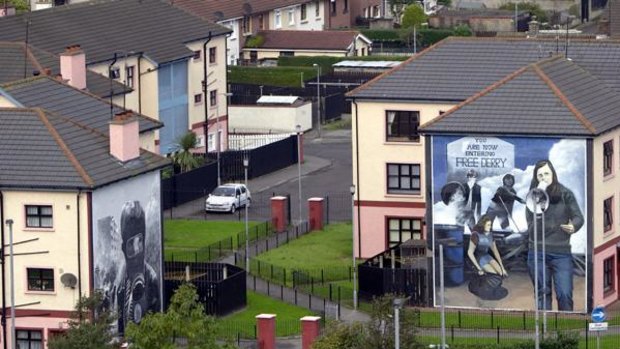
UnspecifiedCredit: Christina Pfeiffer
Christina Pfeiffer takes a stroll through history along Derry's famous fortifications.
The receptionist at my hotel is aloof and unhelpful until I open my mouth and speak. When I hand her my Australian passport, the hotel's basement car park, which only a few minutes earlier was full, suddenly has a vacancy. And if I can't find a spot, I am told to just leave the car anywhere in the basement and bring up the keys for one of the staff to park.
I puzzle over this change in attitude until a taxi driver offers a gem of wisdom. "Over here in Northern Ireland, we love the rest of the world but hate each other," he says, laughing.
Although Northern Ireland's troubles are over, the scars of conflict remain. To fathom why, you must delve into its history.
I meet up with Blue Badge guide Michael Cooper for a private walking tour of the Walls of Derry. Derry is the only city left in the British Isles that is completely surrounded by walls, which form a promenade around the old part of the city.
The Blue Badge is Northern Ireland's highest guiding accreditation. Cooper has a bachelor's and master's degree in Irish politics and history. As we stroll along the walls, Cooper speaks in a strong Northern Irish accent that demands my full concentration. But it makes the experience all the more authentic.
Derry's walls were built between 1613 and 1618 for the defence of settlers from England and Scotland. The walls are magnificent, eight metres high by nine metres wide in some places, and constructed using earth, lime and local stone.
The enmity between Catholics and Protestants goes back to the era when the walls were being built. The settlers, known as planters, were enticed to Derry as part of the plantation program instigated by England's King James I. Catholic Irish locals were uprooted and their lands were redistributed to the Protestant settlers. The name of the city was officially changed to Londonderry but most Irish continue to call it Derry.
The walls were tested during the 105-day Siege of Derry in 1689, when the Catholic King James II, whose crown was under threat from Protestant Netherlands challenger William of Orange, ordered his soldiers to take the fort. The Protestant garrison shut the doors and refused to let the king's soldiers in.
The king's soldiers were unable to breach the walls and, in the end, thousands of people died of starvation.
Cooper points out the four original gates, Shipquay, Ferryquay, Bishop and Butcher, as well as cannons on the walls that were donated by the Guilds of London in 1649.
We stop to admire St Columb's, the first cathedral to be erected in the British Isles after the Reformation. Completed in 1633 for the English and Scottish planters, this Gothic cathedral was extensively restored in the 19th century. Inside, there's a small museum with relics from the Siege of Derry, while a hollow mortar cannonball that was fired into the city by James II's army graces its vestibule. The cannonball carried terms for surrender to which the Protestants within the walls replied defiantly, "no surrender", a common phrase used by Ulster loyalists to the present day.
We stop along a high section of the eastern side of the walls looking down into the Bogside neighbourhood, where rioting occurred in the 1970s and 1980s. Cooper tells us that, during the 19th century, the rich Protestants would walk along the top of the walls to show off the newest fashions to the poor Catholics outside the walls.
Giant political murals illustrate the post-1969 era known as the Troubles. One depicts the events of Derry's Bloody Sunday, when on January 30, 1972, the British Army opened fire on a civil rights demonstration, killing 14 people. Another striking mural is that of 14-year-old Annette McGavigan, the first child victim and 100th victim of the Troubles.
It portrays Annette's innocence against the chaos of those times.
In the heart of the Bogside is the Museum of Free Derry, which has old photographs and displays illustrating the Troubles.
Within the walls, the contrast between Catholic and Loyalist becomes even more evident when you look at the murals in Protestant areas such as Fountain Estate or the Waterside. Here you'll see royalist murals of union jacks and King William. Also within the walls is Tower Museum, the city's main museum, which tells Derry's story from its geological formation millions of years ago, right up to the present.
A large part of Derry was bombed or burnt down during the Troubles and the city has been almost completely rebuilt in the past 20 years. A testament to the new Derry is the Millennium Forum, a gleaming conference and theatre centre offering performances ranging from ballet to comedy.
The writer was a guest of Tourism Ireland and Emirates.
TRIP NOTES
Getting there: Emirates Airline flies to Dubai with a direct connection between Dubai and Dublin on Aer Lingus. Phone 1300 303 777, see http://www.emirates.com.
Staying there: The Tower Hotel Derry is the only hotel within the city walls. Rooms from $100 a night. Phone (+44) 28 7137 1000, see www.towerhotelderry.com.
The tour: To book a blue badge guide, see http://www.derryvisitor.com.
Further information: See www.discoverireland.com.au. Phone Tourism Ireland on (02) 9299 6177.
Sign up for the Traveller Deals newsletter
Get exclusive travel deals delivered straight to your inbox. Sign up now.